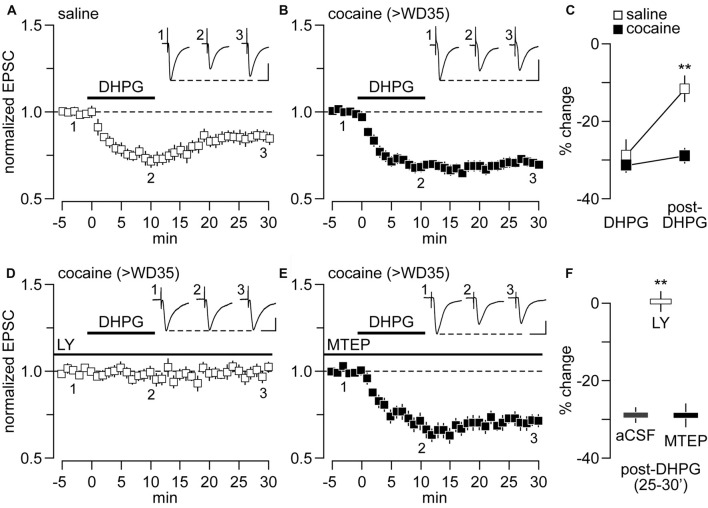Figure 1.
Metabotropic glutamate receptor 1-long-term depression (mGlu1-LTD) is present at nucleus accumbens (NAc) glutamatergic synapses onto medium spiny neurons (MSNs) of rats following >35 days of withdrawal (>WD35) from cocaine self-administration. (A) Bath application of dihydroxyphenylglycine (DHPG; 50 μM) diminished the amplitude of locally-evoked excitatory postsynaptic currents (EPSC)−70 mV by ~30% in NAc MSNs recorded from saline controls but this recovered towards baseline values after 20 min of DHPG washout (n = 14 cells/10 rats). (B) Similarly, DHPG reduced the amplitude of evoked EPSC−70 mV by ~30% in NAc MSNs recorded from cocaine rats. However, no apparent recovery occurred after 20 min of DHPG washout (n = 14 cells/12 rats). (C) Summary of the inhibitory effect of DHPG on NAc MSNs EPSC−70 mV obtained during the last 5 min of DHPG application and washout period. Note that the magnitude of EPSC−70 mV suppression by DHPG is similar between saline- and cocaine-treated groups. However, only the saline group exhibited a significant recovery of the inhibitory effect following DHPG washout (group × treatment interaction F(1,44) = 7.71, p = 0.008; **p < 0.001 vs. cocaine, Tukey post hoc test, two-way ANOVA). (D) DHPG-induced attenuation of locally-evoked EPSC−70 mV amplitude in NAc MSNs recorded from cocaine rats was no longer observed when recordings were conducted in the presence of the mGlu1 antagonist LY367385 (50 μM, n = 9 cells/7 rats). (E) In contrast, this inhibitory effect of DHPG on MSN EPSC−70 mV in cocaine rats remained unaltered with the inclusion of the mGlu5 antagonist MTEP (50 μM, n = 9 cells/7 rats). (F) Summary of the post-DHPG effects shown in (B,D,E; **p < 0.001 vs. aCSF, unpaired t-test). Calibration bars for example traces: 100 pA, 25 ms.

